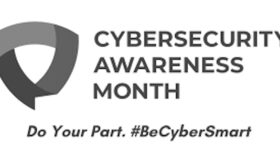National Cyber Security Awareness Month – Mobile Security and Accounts
 Mobile security of your smartphone or tablet, is not rocket science. You can take simple steps to secure your devices and online accounts that protects you from being an easy target. Let’s start with your passwords.
Mobile security of your smartphone or tablet, is not rocket science. You can take simple steps to secure your devices and online accounts that protects you from being an easy target. Let’s start with your passwords.
Passwords
You need to change them and do so on a regular basis. Please don’t be lazy about this simple task. Anyone who knows anything about you can probably guess your password. Especially if you d0 something stupid like use you dog’s name, the street you live on, your favorite shoe designer or sports team. People do these things and, to make it worse, they keep the same password for years. Or, dumber still, they use this same password on all their online accounts. So anyone who guesses it can then take over your life. How do hackers know you well enough to guess your passwords? Facebook! Never, ever, use the same password for multiple online accounts!
Change you passwords at least every six months. Use a lot of numbers and special characters and mix them up good. Your password should look something like this “L*gg46&#wEvF?.” Ugly huh? And hard to remember too. Well try a password manager. They are easy to use and free. Check “The Best Free Password Managers of 2017” from PC Magazine.com.
Device safety
Do you know what your device is doing? It does all kind of things when you are using it, and when you’re not. Practicing good cyber security means understanding what your device is doing and how to spot trouble and stop it. Take the time to learn all about your mobile device.
Make sure you update your phone’s operating system and apps regularly. Companies are always finding flaws and security issues and they issue updates and patches when they do.
Online accounts
Consider this, any account you have online can be monitored to see what recent activity has occurred. Ok, so who does not have a Facebook or social media account of some kind?To see what’s happening with your Facebook account click here. Facebook offers all its users a page that will tell them if someone has been accessing their accounts. If you have a Twitter account click here, for Google click here. These links will take you to the pages you need to monitor your account activity. Do yourself a favor and bookmark them for future use. It doesn’t take long to check these sites for unusual activity. And check them regularly.
You will also find ways to block any unauthorized activity on your accounts. Some apps and services allow you to set up alerts that come to you via a text message or email when something funny is happening to your accounts. They will also alert you when you log in from a new device or from a different location.
Check your apps
Another thing you need to do is check the app permissions on your phone or tablet. Apps communicate with their maker regularly. Most of the time its things like performance reports if the app crashes or updates. But trust me, it is communicating. You need to understand what your phone is doing and what permissions it has to access your data. Apps can do things like monitor your position using GPS, copy your text messages, access your contacts and spy on you using the on-board camera. Most people don’t realize how much data their phone and the associated apps give away. Don’t just click on the “accept” link when an app asks for permission to access your phone’s features. Investigate and ask yourself, why?
Apps from third party vendors are a good source of trouble. Games, shopping apps, email apps, any app can be malicious. Hackers count on you not looking at the app too closely, especially the part about permissions to access things like your email, camera or GPS. Think it can’t happen to you? Think again!
You should also be aware of a new threat that is hitting mobile devices, it is known as ad and click fraud. It is a direct result of clicking on a link in an email or text message. Clicking on mysterious links is a s good way to introduce malware into your device.
Free Wi-Fi
Set up your phone to ask permission to join open wi-fi networks like you find at Starbucks. These open networks, or free wi-fi, are havens for hackers. When you are traveling make sure you know what the hotel or airport wi-fi name is. A new tactic for hackers is to set up their own wi-fi networks close to or inside the hotel. They give their wi-fi a name similar to that of the hotel’s. If you are not paying attention you might get on a hacker’s wi-fi. Hackers can see everything you do if you are on their phony network and that could be big trouble. Learn to you use a VPN or tether your device to your smartphone for secure Internet access. Better yet, get your own wi-fi hotspot. Many of the major cellphone service providers offer them.
Now you know.






